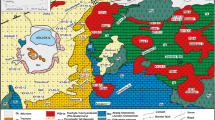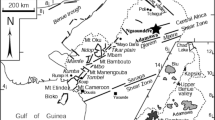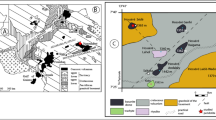Abstract
The trachyandesite lavas from Heikongshan volcano of the Tengchong volcanic cluster, Yunnan Province contain relatively abundant mafic and ultramafic small xenoliths comprising mainly gabbro, pyroxenite and rare lherzolites, all less than 2.5 cm in size. Gabbro xenoliths are characterized by “open” texture represented by relatively abundant vesicles and ground-mass fillings, while pyroxenite xenoliths are characterized by equigranular and poikilitic texture. Their mineral compositions (clinopyroxene ± orthopyroxene ± plagioclase) are similar to those of phenocrysts in lavas, and their equilibration temperature (1000–1125°C) is consistent with the crystallization temperature of the phenocrysts (998–1108°C). Thus, the textures and compositions of these xenoliths are different from those of lower crustal and mantle xenoliths, and were derived from the magma chamber. Among them, the gabbroic xenoliths come from the crystal-bubble-liquid zone at the top of the magma reservoir, while the pyroxenite xenoliths come from the cumulates in the bottom of magma reservoir. The studied single lherzolite xenolith with porphyroclastic texture has similar mineral compositions to the mantle xenoliths from eastern China, and is considered to be of upper mantle origin. It was brought into magma reservoir by replenishment magma, and might have experienced a cooling event before eruption. The formation of xenoliths in trachyandesite flows largely reflects the ascent, storage, evolution and eruption processes of magma.
Similar content being viewed by others
References
Nixon P H. Mantle Xenoliths. New York: John Wiley and Sons, 1987. 1–904
E M L, Zhao D S. Cenozoic Basalts and Deep-seated Xenoliths in Eastern China (in Chinese). Beijing: Science Press, 1987. 1–478
O’Reilly S Y, Griffin W L. 4-D lithospheric mapping: Methodology and examples. Tectonophys, 1996, 262: 3–18
Rudnick R L. Xenoliths—Samples of the lower continental crust. In: Fountain D, Arculus R, Kay R W, eds. Continental Lower Crust. Amsterdam: Elsevier, 1992. 269–316
Rudek E A, Fodor R V, Bauer G R. Petrology of ultramafic and mafic xenoliths in picrite of Kahoolawe Island, Hawaii. Bull Volcanol, 1992, 55: 74–84
Fodor R V, Rudek E A, Bauer G R. Hawaiian magma-reservoir processes as inferred from the petrology of gabbro xenoliths in basalt, Kahoolawe Island. Bull Volcanol, 1993, 55: 204–218
Fodor R V, Moore R B. Petrology of gabbroic xenoliths in 1960 Kilauea basalt: Crystalline remnants of prior (1955) magmatism. Bull Volcanol, 1994, 56: 62–74
Laiolo M, Cigolini C. Mafic and ultramafic xenoliths in San Bartolo lava field: New insights on the ascent and storage of Stromboli magmas. Bull Volcanol, 2006, 68: 653–670
Liu R X. Active Volcanoes in China (in Chinese). Beijing: Seismological Press, 2000. 35
Jiang C S, Zhou R Q, Zhou Z H, et al. Division of tectonic elements in west Yunnan and its neighboring regions and their features (in Chinese). J Seismol Res, 2000, 23: 21–29
Jiang C S. Distribution characteristics of Tengchong volcano in the Cenozoic era (in Chinese). J Seismol Res, 1998, 21: 309–319
Li D M, Li Q, Chen W J. Volcanic activities in the Tengehong volcano area since Pliocene (in Chinese). Acta Petrol Sin, 2000, 16: 362–370
Fan Q C, Liu R X, Wei H Q, et al. The magmatic evolution of the active volcano in the Tengchong Area (in Chinese). Geol Rev, 1999, 45(Suppl): 895–904
Cigolini C, Kudo A M. Xenoliths in recent basaltic andesite flows from Arenal Volcano, Costa Rica: Inference on the composition of the lower crust. Contrib Mineral Petrol, 1987, 96: 381–390
Shi L B, Lin C Y, Chen X D, et al. Discovery of mental-derived micro-xenoliths from Quaternary basalts in northern Hainan island and its geological implication (in Chinese). Seismol Geol, 2003, 25(Suppl): 33–42
Smith J V. Feldspar Minerals. New York: Springer-Verlag, 1974. 447
Chen X D, Lin C Y, Shi L B. Rheology of the lower crust beneath the northern part of North China: Inference from lower crustal xenoliths from Hannuoba basalts, Hebei Province, China. Sci China Ser D-Earth Sci, 2007, 50: 1128–1141
Poldervaart A, Hess H H. Pyroxenes in the crystallization of basaltic magma. J Geol, 1951, 59: 472–489
Le Maitre R W, Bateman P, Dudek A, et al. A Classification of Igneous Rocks and Glossary of Terms. Oxford: Blackwell, 1989. 193
Wells P R A. Pyroxene thermometry in simple and complex systems. Contrib Mineral Petrol, 1977, 62: 129–139
Wood B J, Bano S. Garnet-orthopyroxene and orthopyroxeneclinopyroxene relationships in simple and complex systems. Contri Mineral Petrol, 1973, 42: 109–124
Brey G P, Kohler T. Geothermobarometry in four-phase lherzolites II. New thermobarometer and practical assessment of existing thermobarometers. J Petrol, 1990, 31: 1353–1378
Nimis P, Taylor W R. Single clinopyroxene thermobarometry for garnet peridotites. Part I: Calibration and testing of a Cr-in-Cpx barometer and an enstatite-in-Cpx thermometer. Contrib Mineral Petrol, 2000, 139: 541–554
Huang X L, Xu Y G, Lo C H, et al. Exsolution lamellae in a clinopyroxene megacryst aggregate from Cenozoic Basalt, Leizhou Peninsula, South China: Petrography and chemical evolution. Contrib Mineral Petrol, 2007, 154: 691–705
McCarthy T C, Patino D A E. Empirical calibration of the silica-Ca-tschermak’s-anorthite (SCAn) geobarometer. J Metamor Geol, 1998, 116: 675–686
Huang X L, Xu Y G, Wang R C, et al. The Nushan gruanulite xenoliths from Anhui Province, China: Mineralogical characteristics, the lower crustal geotherm and their implications for genesis (in Chinese). Acta Petrol Sin, 2002, 18: 383–391
Lin C Y, Huang X L, Xu Y G, et al. Thermal structure and rheology of the upper mantle beneath Leizhou Peninsula, Guangdong Province, China (in Chinese). J Tropical Oceanogr, 2003, 22: 49–62
Huang-Fu G, Jiang C S. Research on Tengchong volcano (in Chinese). Kunming: Yunnan Science and Technology Publishing House, 2000. 418
Kan R J, Zhao J M. The deep structure and the geophysical field in Tengchong volcanic area (in Chinese). In: Liu R X, ed. Volcanism and the Human Environment. Beijing: Seismological Press, 1995. 88
Author information
Authors and Affiliations
Corresponding author
Rights and permissions
About this article
Cite this article
Yu, H., Lin, C., Shi, L. et al. Characteristics and origin of mafic and ultramafic xenoliths in trachyandesite lavas from Heikongshan volcano, Tengchong, Yunnan Province, China. Sci. China Earth Sci. 53, 1295–1306 (2010). https://doi.org/10.1007/s11430-010-4044-6
Received:
Accepted:
Published:
Issue Date:
DOI: https://doi.org/10.1007/s11430-010-4044-6




